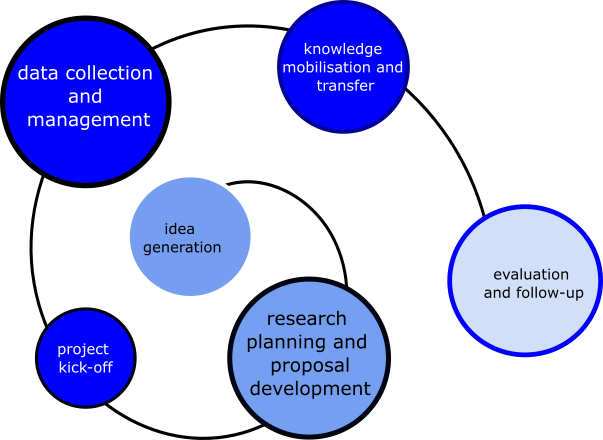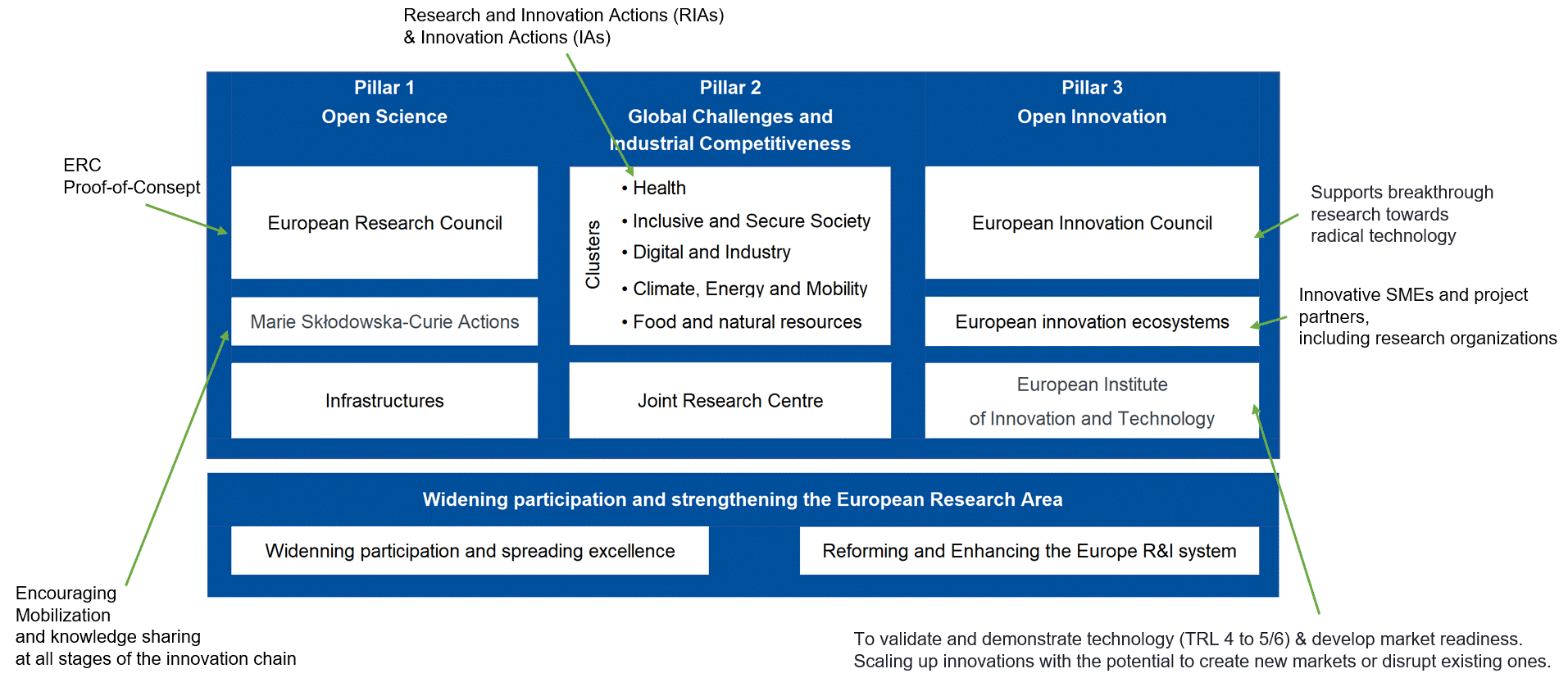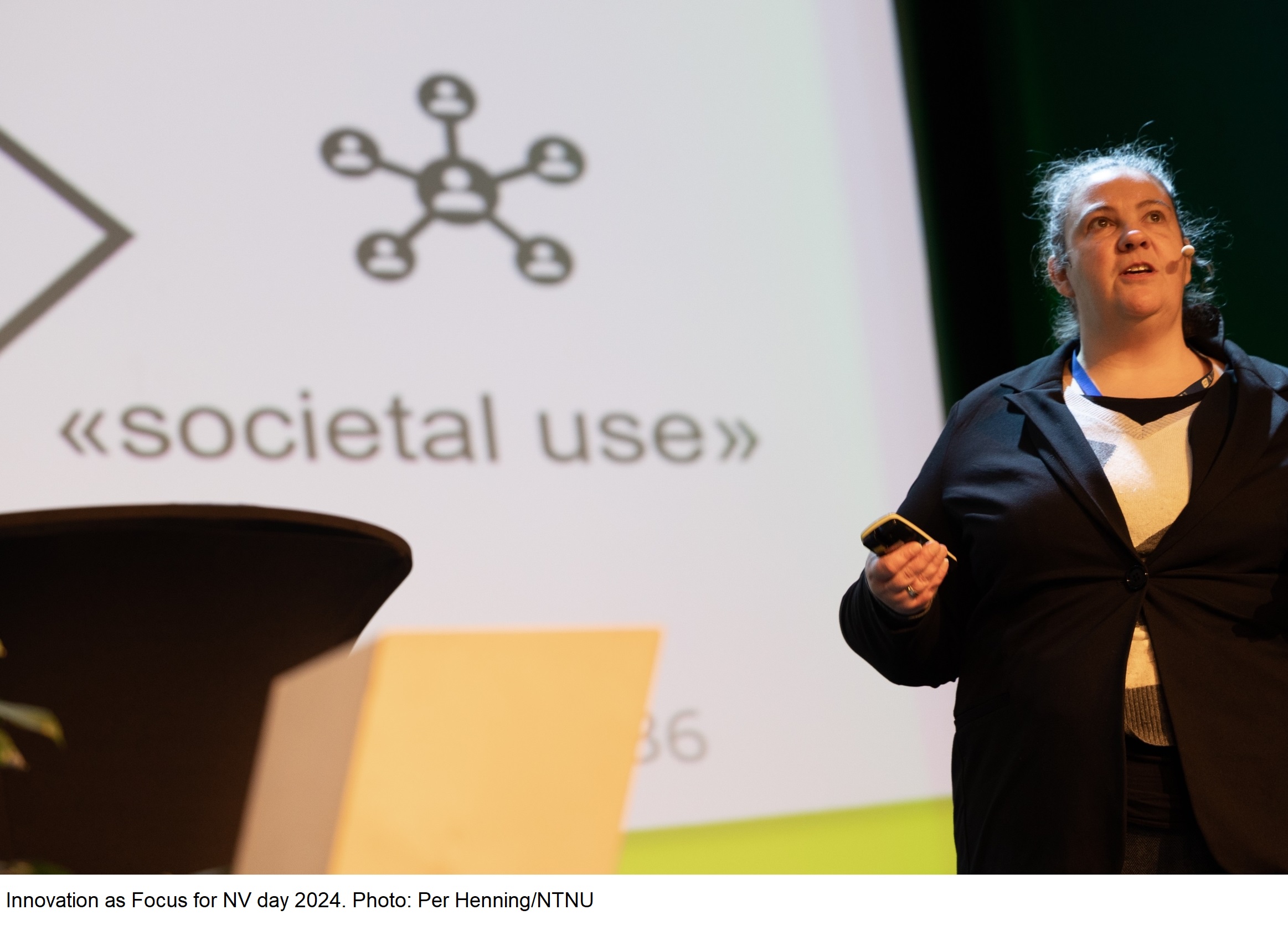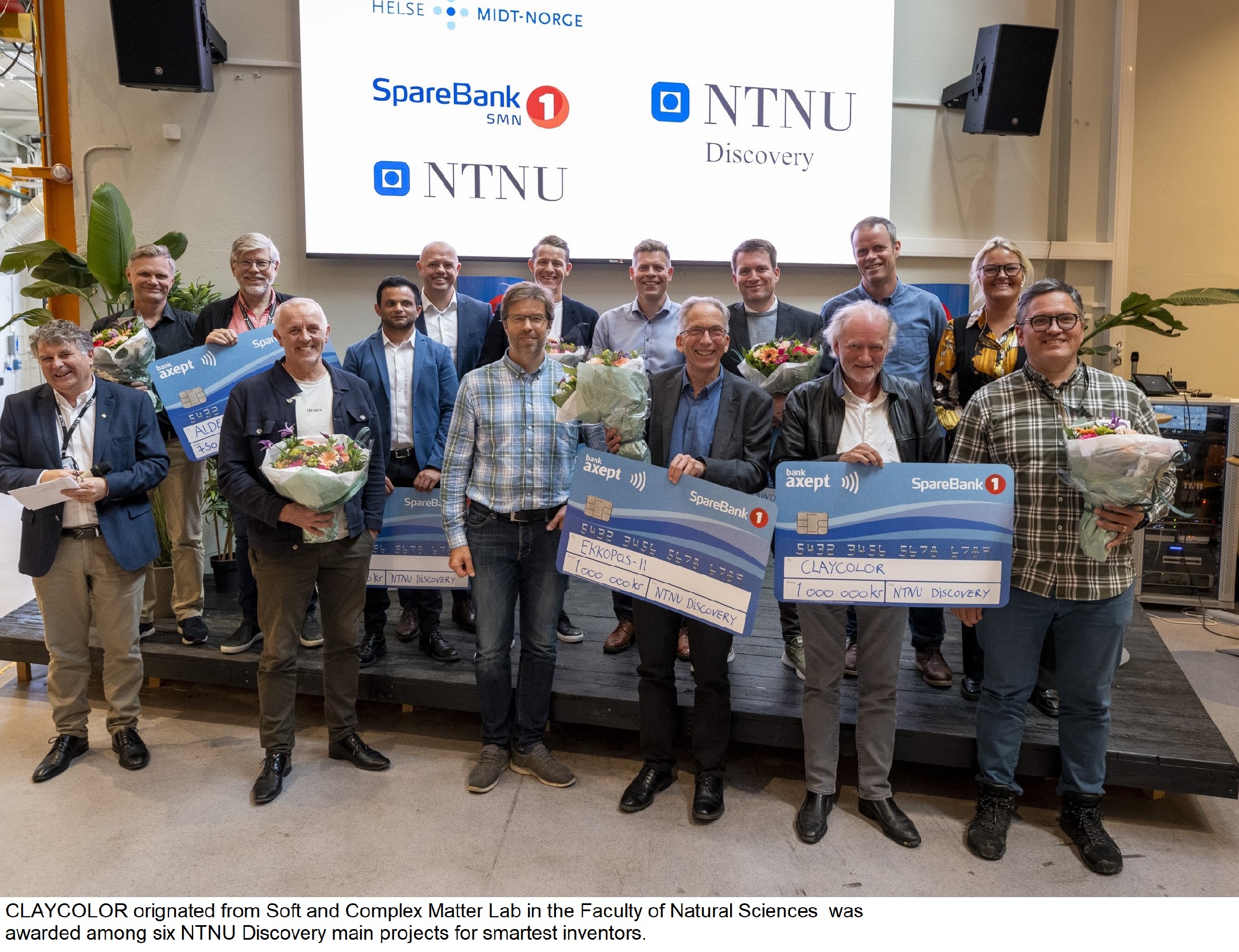NV Innovation Gateway
Read more -> stories on innovation from NV faculty
“An innovation is something that is new, useful and utilized ( in norwegian: ny, nyttig, nyttiggjort!) and the process of innovation is going from something that is new, identifying it’s usefulness and bringing it to use in society. So essentially the process of getting knowledge in use.
At NV our research has potential to be world changing. Our innovations activities are part of the process of innovation, but that doesn’t mean that you as an academic have to take responsibility for every stage in the process. We can think of it like a relay race, you can hand the baton on for the next stage but there are still some thing you need to know to facilitate getting the knowledge you generate «in use».
We don’t necessarily know in advance what research will lead to innovation. Sometimes we expect our research to produce innovation, or knowledge that should be brought directly to societal use (for example working in SFI’s or on Missions or Societal Challenges in Horizon Europe) but all research can lead to innovation or opportunities for use in society, even if it wasn’t foreseen, so it’s important to be familiar with the basic concepts to avoid problems down the line.”
By Catherine Taylor Nordgård, Vice Dean for innovation, NV faculty
Innovation is one of three core tasks in Strategy 2018-2025 for the Faculty of Natural Sciences (NV)
The Academic Innovation Landscape
Research work and funding is often geared towards meeting societal challenges, funders want to know how your proposed project will make a positive impact and research council national evaluations include impact cases as standard. So a basic understanding of the landscape of innovation in academia is an important part of the modern academic toolbox.
Knowledge Valorization
Improving the valorization of research results is key to reduce the innovation gap, and respond to the real needs of society.
Quick checkpoints to streamline practice for Knowledge Valorization.
Intellectual Property (IP) and Intellectual Property Rights (IPR) In Research and Innovation
NTNU has a responsibility to ensure that the knowledge we produce benefits society and that includes effective innovation and knowledge management through generation of IP, clarifying IPR and IPR protection. The strategy for management and protection of IP is part of the “Measures to Maximise Impact”. To realize successful exploitation, IP takes an essential role in the entire life cycle of knowledge generation and development. For more from NTNU Innovation and Knowledge Management web site
And specifically about NTNU’s IPR policy and NTNU’s guidelines for IPR here Why IPR policy – NTNU.
Essential points about Open Science (Open Access)
- Open Science (Open Access) implies that research data shall be deposited as soon as possible.
- The dissemination of results can be postposed to allow the appropriate protection of results beforehand.
- Works in open access are usually protected by copyright, but other IP rights may protect the underlying content. A publication made available as open access, may also have the method described protected by a patent and/or design rights, and software code protected by copyright. Be ware there is no inherent conflict between protection and openness
To gain confidence in the application of IP within the context of Open Science , EU IP Helpdesk made training material on IP & Open Science ,providing:
- interpretations and demonstration on how the IP system aligns with the core principles of Open Science .
- examples showcasing how the sharing of IP, data, and publications can be as open as possible while maintaining the option for closure when necessary.
To ensure that results created at NTNU through the use of NTNU’s resources or public funds are used in society, including commercialization, new research and teaching,
According to NTNU’s IPR policy, "all Results, IP, Data and Physical Material with a potential for commercial utilization must be reported by the employee (creator) to the university through the employee’s line manager and to NTNU TTO (Submit your idea to TTO) ."
NTNU Innovation and Knowledge Management web site
Even if ownership rights of IP are transferred to NTNU, the authors always retain the moral rights to their own literary, scientific or artistic work, that is, the right to claim authorship (the right of attribution) and the right to object to any distortion or modification of a work (the right of integrity).
Visit European IP Helpdesk for details: user friendly learning resources for knowledge of IP and IPR in the context of research and innovation at basic, intermediate and advanced levels.
Some selected topics:
IP for Future and emerging technologies: examples on how analysis of patenting activity can help radical technology breakthrough in context of EU future and emerging technologies (FET) or Pathfinder (similar to Technological Convergence Related to Enabling Technologies). Learn from EU IP Helpdesk webinar.
The protection of biotech inventions by appropriate Intellectual Property Rights is extremely important due to the close link between such innovations and the development of a product. Learning from EU IP Helpdesk webinar.
Maximising the impact of Horison Europe projects through effective communication, dissemination and exploitation activities: This eLearning module clarifies the terminology by illustrating the differences between the three concepts and providing an overview on key practical steps and central aspects related to IP and innovation management. Learning from EU IP Helpdesk webinar.
Licensing is a transfer of rights from a licensor, typically the owner of an IPR, to a licensee.
It is an effective means for licensor to control use or diffusion of IP. Knowledge (or IPR) often need to be shared with others in context of collaborative research and open innovation. Licensing strategies can be employed to balance various goals in joint efforts, in particular, to manage protected knowledge that is developed and shared in collaborative innovation.
The core element in licensing is to the scope and extent of the rights granted to the licensee, as well as any limitations on those rights. Here are typical examples used in collaborative innovation for specifying extent and limitations via licensing:
- Time (effective period)
- Use only for research or education
- Exclusive /non-exclusive rights
- Operation conditions (defined obligations to use the IP)
- Regional/geographical territory
- Field of use
- Access and usage rights
- Right to commercialization
Integrating Collaboration, Innovation and Value Creation in Projects

Stakeholder contact can:
- Deepen inside understanding to problem and help with identifying unmet needs / unanswered questions
- Allow you to meet potential partners
- Provide access to new opportunities, data, resources, technology and knowledge
- Bring new inspiration to your own work
- Partnering with others can provide resources and capacity
- It can be necessary to consider the following aspects in discussing initiatives:
- Protected background (aware of existing IP (or Background IP) rights)
- Disclose the potential of the new ideas, but not the “how”
- Have a non-disclosure agreement (NDA) prior to any discussion related to confidential information (trade secrets, know-how or new ideas).
- Exploratory discussion under NDA
- Make the purpose of the disclosure clear in the NDA
- An NDA only covers scope of disclosure, NOT commercial transactions
- Consider a material transfer agreement (MTA) if sensitive samples need to be shared
- NTNU has regulations and templates of aggreements (webside in norwegian, but NDA and MTA template in english)
- Get guidance on consortium agreements and IP agreements
- Create a common vision regarding innovation and impacts beyond the project – what are the next steps and who will drive them?
- There is useful guidance for managing innovation projects with external partners in NTNU’s advice and guidance for SFI’s (in norwegian)
- Project kick off
- Consortium and project agreements in place as neccessary
- Use the kick off period to cement the common platform and strategies agreed in the project proposal
- Result collection and management
- Keep in mind when capturing outputs under collaboration
- Which partners contributed (and what) – to determine owners: Background IP and Project IP
- The use of IP (results from the work) is relative stand-alone independent of use of other IP
- Any agreed strategies for protecting results new IP
- Any plan or agreement of IP management and exploitation
- Any relevant confidentiality agreements needed or signed in advance
- Any publications or public disclosure already made?
- Individual personal role (students, employee, visitors, the advisory board, etc) in IP creation
- Open science and IP – as open as possible as closed as neccessary. This requires continual evaluation of «value» and innovation potential. Be ware of notification obligation in NTNU IPR policy
- Open data and FAIR
- Keep in mind when capturing outputs under collaboration
- Knowledge mobilisation and transfer
- Identify technology outputs and engage with TTO under notification obligation
- Dissemination / communication strategy, who is this knowledge relevant to and how will they learn about it?
- Academic routes (conferences, publications)
- Towards non-academic stakeholders
- Make your research more visible. For more on Make your research more visible - Knowledge base – NTNU
- Keep in mind the potential for follow up or spin out projects
- Strategy towards Impact – who follows up what?
- Who exploits what, where and how?
- Freedom to Operate (FTO): no interest conflict or infringement with existing patents
- Freedom to Operate Search(FTOS) if necessary
- Evaluate the status of the new findings by technical readiness level (TRL) and commercial readiness level (CRL)
- Potential financial fundings or facilities beyond the current collaboration work
- How and under what terms, is IP made available for commercial or other use
- Initiation of new projects (what type, research / innovation /business developement
- Technology readiness level (market readiness level) assessment if appropriate
- Assess potential broadening in fields of use and emerging markets
- Evaluating Impact and more from Science Conversations - Innovation and impact – NTNU;
Collaboration Creates Innovation

Network & Forum
- Framework Collaboration
- Forum for Industrial Cooperation
- Guest/adjunct professors from outside academics
- Industrial/Public Sector PhD Scheme
- Gemini Centres at NV

Public Sector
To increase societal impact and benefit
- Helping generation of knowledge relevant and applicable to public actors and their users.
- Providing knowledge and innovation for supporting the public entity’s R&D and innovation strategy.

Industry/Academics
Through SFI, FME centre or other projects
- Contribute to increased competitiveness of industry
- Provides competent candidates, knowledge and technology innovation.
Our stories: collaboration across academics and industries at NV

New Business
Employees and students help to identify new business opportunities and inventions as well as innovative improvements in existing processes.
Check points in practice
During the process for generation and development of IPs, some points need to be checked depending on the role of a person in the project and nature of the project.
Prior to idea generation/During establishment of project consept
- Confidential agreement (english template available)
- IPR management in the project
- Project background
Idea validation/During the project
- Monitering results generated in the project work
- Student work: moral right, copyright, ownership right, publication in NTNU open
- Public disclosure V.S patenting
- NTNU IPR policy (obligation to notify all results and all physical material with the potential for commercial exploitation)
- Applicability of Open Data principle
- Ph.d work and thesis: NTNU Open (with defined publication time restriction), ownership right clarification, free of charge to use the results of the work for teaching and research purposes (Yes) with caution of IPR protection
- External organization: restriction time on publication, ownership right, transfer the right of the invention to the organization
Creating more values/Beyond the project
- Exploitation of results
- Increase the visibility of the work/outcomes
- New opportunities for further development
- New agreements/licensing
- Talk to the supervisor or project manager: potential value of new IPs and eventually notificaton of IP
- Avoid too early public disclosure (for instance, public presentation, preparing articles or open source coding)
- NTNU IPR policy (obligation to notify all results and all physical material with the potential for commercial exploitation)
- Any relevant specification according to Agreement concerning admission to organized doctoral degree education (Ph.D)
- Postpone public disclosure for making a decision concerning patenting/commercialization.
- Postpone publication on NTNU Open (in particular for Ph.d thesis)
Opportunities and resource to further exploit the results
- NTNU's entrepreneurship ecosystem
- NTNU Discovery – Low threshold funding scheme for verifying commercial potential of research results
- Commercialization Project – The Research Council of Norway
- Grant for Student Entrepreneurship (STUD-ENT) from Innovation Norway (Possible for Ph.D; in Norwegian)
- EU funds
Students in the project, typically for summer job in NTNU labs, specialization and master thesis project in the last year.
- Student and business cooperative agreements(if with externals). If results built on the project background owned by the external, a separate agreement is required for the student and the external.
- Acceptance - transfer of rights to NTNU (ownership transfer)
- Confidential Agreement Confidentiality agreement between student and NTNU - particularly sensitive projects
- Postpone publication on NTNU Open
If you are student and considering to start new business upon IPR clarification,
practical help and support resources in NTNU to start a new business
Diverse Career Paths
It is increasingly recognized that competencies related to innovation and societal engagement are also highly relevant in academia, leading to a greater diversity of career paths. This is also reflected in the assessment of academic activities and research proposals as well as in the framework for assessment of academic carrier by CoARA and NOR-CAM.
There are also both local, national and European possibilities for funding innovation activities as part of your academic career. Involvement in innovation project and developing these competencies can positively contribute to an academic career and a greater overlap in skills for careers both within and outside academia promotes more career mobility.
In addition to the implementation of CoARA, incentives are made to stimulate more innovation initiatives. With purpose to encourage individual engagement of innovation activities, NTNU provides NTNU Discovery as financial support to the development, verification and quality assurance of good and commercially viable business ideas.
- NTNU Discovery pilot project for employee/student
A pilot project provides the opportunity to verify, investigate or create a prototype to minimize technical and commercial risk in the future. Employees may apply for a grant of up to NOK 200 000. Grants of up to NOK 75 000 are available to students.
- NTNU discovery main project
Main project is for more mature and verified idea. Employees may apply for a grant of up to NOK 1 000 000. Grants of up to NOK 300 000 are for students.
- NTNU Stipendiat for innovation for freshly graduated Ph.D
Supporting activities which have potential to drive innovation and establish new business.
Both nationally and internationally, initiatives have been launched to change how academic activities are assessed in academic careers and in competition for research funding. The Research Council of Norway (RCN) increasingly requires that the social benefits of research work shall be addressed as important element in proposing ideas and planning activities. In addition to increasing support for cross-sectional collaboration, the following are particularly innovation focused:
- Qualification Project
to support the investigation activities for translating research results and strengthening the commercial potential.
- proof-of-concept-project
To support concept verification and increase the commercial application of results from publicly funded research projects. There is no specific requirement for high Technology readiness level (TRL).
- STUD-ENT from Innovation Norway
To support student (Ph.d can be eligible) with new start-up idea.

- ERC Proof of Concept
Frontier research often generates radically new ideas that drive innovation and business inventiveness, and tackle societal challenges. The ERC puts particular emphasis on the frontiers of science, scholarship, and engineering. ERC funding may also enable new ways of working in the scientific world, with the potential to create breakthrough results and facilitate commercial and social innovation potential of funded research. The ERC Proof of Concept Grants aim at facilitating exploration of the commercial and social innovation potential of ERC funded research.
- Marie Skłodowska-Curie Actions
Innovation as important element has been addressed:
- MSCA Staff Exchanges To promote innovative international, inter-sectoral and interdisciplinary collaboration in research and innovation through exchanging staff and sharing knowledge and ideas at all stages of the innovation chain.
- MSCA Postdoctoral Fellowships: to enhance the creative and innovative potential of researchers holding a PhD. The scheme also encourages researchers to work on research and innovation projects in the non-academic sector.
- MSCA Doctoral Networks: to train creative, entrepreneurial, innovative and resilient doctoral candidates, able to face current and future challenges and to convert knowledge and ideas into products and services for economic and social benefit.
- Pillar 3: Open Innovation
Supporting activities which have potential to drive innovation and establish new business. Two types: “Open” with no-predefined area or with specific themes
- European Innovation Council (EIC) Pathfinder
Supports potential radical breakthrough of new technologies at early phase of development (TRL 1-4). Two types: Pathfinder “Open” with no-predefined area; Pathfinder “Challenges” with specific themes.
- European Innovation Council (EIC) Transition
support activities for the maturation and validation of novel technology in the lab and in relevant application environments as well as for the development of a business case and (business) model towards the innovation’s future commercialization. Only for the results regenerated under Horizon 2020 or Horizon Europe. It is expected to demonstrated intended application (TRL 5/6) and higher market readiness.
- European Innovation Council (EIC) Transition
European Innovation Council (EIC) Accelerator. Funding to scale up innovations building on scientific discovery or technological breakthroughs (‘deep tech’). Encourage start-ups and SMEs.
- European Innovation Council (EIC) Pathfinder
- COST Innovators Grant (CIG)
The European Cooperation in Science and Technology (COST) is a funding organisation for the creation of research networks, called COST Actions. These networks offer an open space for collaboration among scientists across Europe (and beyond) and thereby give impetus to research advancements and innovation.
The COST Innovators Grant (CIG) aims to enhance the pace and success of research breakthroughs and as such, offers ending Actions the possibility to create additional impact during the year after the end of the Action. CIGs have a duration of 12 months and benefit from the same networking activities available to COST Actions.



